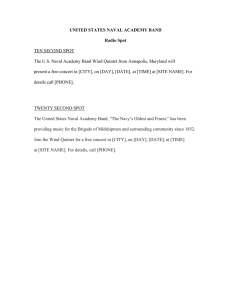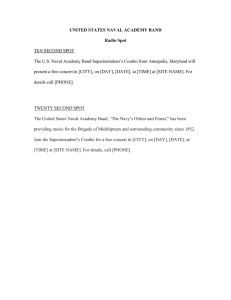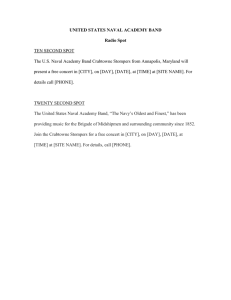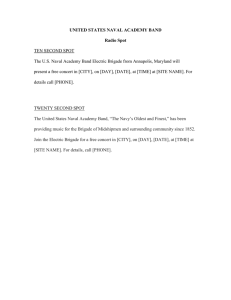K.,
advertisement
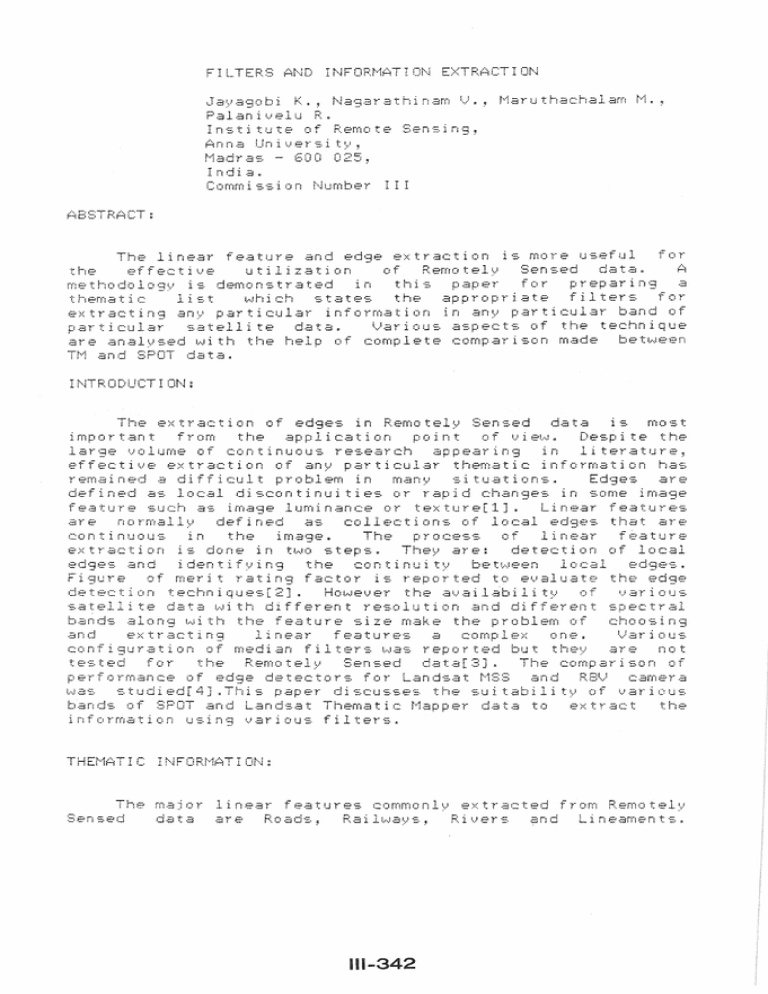
FILTERS AND INFORMATION EXTRACTION athinam V., Maruthachalam M., agobi K., Palanivelu R. Institute of Remote Sensing, Anna University, Madras - 600 025, India. Commission Number III ABSTRACT: The linear feature and edge extraction IS more useful for the effective utilization of Remotely Sensed data. A methodology is demonstrated in this paper for preparing a thematic list which states the appropriate filters for extracting any particular information in any particular band of particular satell te data. Various aspects of the technique are analysed with the help of complete comparison made between TM and SPOT data. INTRODUCTION: in Remotely Sensed data is most The extraction of important from the application point of view. ite the large olume of continuous research appearing in literature, effective extraction of any particular thematic information has are remained a difficult problem in many situations. defined as local discontinuities or rapid changes in some image feature such as imaqe luminance or texture[l]. Linear fea ures are normally defined as collections of local that are continuous in the image. The process of linear feature extraction is done in two steps. They are: detection of local and ident fying the continuity between local Fiqure of meri rating factor is reported to evaluate detection techniques[2J. However the avail ility of various satellite data with different resolution and dif eren spec ral bands along with the feature size make the problem of choosing and extracting linear features a complex one. Various configu ation of median filters was reported but t are not ested for the Remotely Sensed data[3J. The comparison of performance of detectors for Landsat MSS and RBV camera was studied[4].This paper discusses the suitability of various bands of SPOT and Landsat Thematic Mapper data to extract the information sing various filters. THEMATIC INFORMATION: The major linear features commonly extracted from Remotely Sensed data are Roads, Rivers and Lineaments. Rai s, III these Becau ·::;.e 0 f t r'le spectral complexity and limited width of of pixels representing these features appear in fe.3ture·:;" '::;.atell i te data most often as ramp s, hence there is a need H01..·.Je er" in one for isolating such features for clarity. the particular band, it is not s possible to e::<t'ract different kinds of linear features. For example, roads may behave as a sensible in one band but not in another band. Similarly, a river may be extracted more clearly in a particular band than in another band. The capability of the operator to detect the ramp is therefore important in thematic mapping and the list which can suggest the suitable spectral band along with suitable operator for extracting the information may be more useful for an analyst. Road, river and railway are the features selected for preparing the thematic list and different familiar operators were tried to extract the features and to assess the performance of the operators. l.} ALGOP, I THt"'1: Algorithms chosen for the analysis were: Sobel K i ·r·:;.ch F~.o ber t s Data with and without noise were used to extract the features and the above alogrithms. Median filters of different size were used to smooth a noisy data and the restored data was used to extract information using the above algorithms. Two level bidirectional median filters of various size were used to restore the striped data and the extracted were compared with the extracted with the simple median filters. The algorithm of the two level bidirectional median filter of size 5x5 is given below (m~n)=MEDIAN[Y (m,n)ql 1 Li"'1+ (m~n),x(m,n)] R1 U"'1+ Y (m,n)=MEDIAN[x(m-2,n),x(m-l,n),x(m+l,n),x(m+2,n), lLM+ x(m,n+l),x(m,n+2),x(m,n-l)~x(m,n-2), ;.::(rn,n)] Y (m,n)=MEDIAN(x(m-2,n-2),x(m-l,n-l),x(m+l,n+l), RILM+ x m+2,n+2)~x(m-2,n+2),x(m-l,n+l), x(m+l,n-l),x(m+2,n-2),x(m,n)] ~·'·~here . .( x(m,n) coloumn (m~n)is th~ output pixel value is the pixel value of the m/th row and n/th Operators of different size were used to the compare the quality of the output. Ine ·re·==.ul t,::;. of performance of these operators are discussed in the analysis p.::n" t • III-","""""""Ii"","",, ANALYSIS: The algorithms were implemented in VAX 11/780 SPOT Multispectral(Scene system and tested on Panchromatic (Scene SPOT ID:SIH1860322052339) , data(Scene ID:SIH1860322052337) , and Landsat TM ID:T511420518671201) The possibility of extracting particular feature is graded as suitable, can be used and not suitable. The relative oerformance of the different algorithms is also compared. Rows one to six of figure 1 show the intersect on of a railway track with a metalled road. The horizontal line represents the railway track, and the vertical line represents he road. First coloumn of figure 1 represents the original data of al the bands except thermal band. Coloumn two, three and fou represen the extracted using ROBERTS,KIRSCH and SOBEL operato s correspondin y. Bands 1 to 5 and 7 are shown in rows one to six respectively. Row seven represents the SPOT Panchromatic channel data used to extract the road feature and Row ei t the features extracted using the three operators. represents the SPOT Panchromatic channel data used to ext act the ver feature and the features extracted using the three operators. Rows one to three of figure 2 represent bands 1,2 and 3 of SPOT Multispectral data which shows the intersection of a railway with a metalled road. First coloumn of fiqure 2 shows the original data and coloumns two to four show the extracted s using the three operators. Coloumn one of rows three to six of figure 2 shows the SPOT Multispectral data used to extract the river feature. Coloumns two to four of rows four to six represent the feature extracted using the d fferent operators. Figure 3 represents the original data and extracted edqes of the river feature from bands 1 - 5 and 7 using the ROBERTS, Figure 4 SOBEL and KIRSCH operators respectively. epresents the various configuration of median filters used 0 resta e the aded data. Noise was simulated in the TM data and the extraction of the above thematic information was attempted. The n isy data was smoothed with median fi ters of various configuration and the two level bidirectional median filters. s were ext acted from this res ored data and the output was compared to see the relative merit of the median filter configuration ,along w th the size. RESULTS: Table I illustrates the suitability of various operators along with the pixel resolution. The relative performance of the operators from the application point of view 1S also graded. Band 1 and band 2 of SPOT Multispectral data equally offers good solution for the extraction of river feature. Among the operators used ROBERTS offers best extraction. SOBEL offers qood extraction and KIRSCH operator III is not bet er than ROBERTS and SOBEL in this particular feature ex raction. SOBEL operator is performing v y well compared to other operators in the river feature extraction in the SPOT Band 3 of Landsat TM is more advantageous Panchromatic data. than other bands for river feature extraction. Multispectral data is relatively better to other bands for extracting road features. ROBERTS operator is performing very well in the extraction of road feature from SPOT Panchromatic Band 3 of Landsat TM data is more useful to extract the road feat re information. Band 3 of SPOT Multispectral da a is ruse u 0 ex ract the road feature. Band 4 of Landsat TN is qu e useful to extract the rai feat re informatio Table II gives the relative performance of the various configuration of the median filters along with the size and relat e comp tai nal time. cot··,JCLU::;; I KIRSCH SOBEL and ROBERTS algorithms perform dif erent y for different feat re ext action and their el tional performance s tabulated. This thematic 1 s may be lJ':;eful to applied scientists in Remote Sensing area in ds of Landsat TM and SPOT selecting appropriat f 1 ers and configurations attempted da a Of the median filter bidirect onal rotational filters are good in preserving the smal est WI th features such as roads and rai ways REF E REt···~ CE ~=; 1. Bri Burns, Allen R Hanson, Edward M.Riseman., . ' E}:: t't"act i n'3 ·;.tr.31 t lines.··· ~ EEE Tran';::..3ct i on':;:· Pat ern An .31 9 '::;. i·::. and /','1 a chi n e I n t elI i '3 e nee I..) I) 1 II of II 2. ,3Ti·::;:.on of Detection Anu aPE, Daval1 u F., "r"1achi ne pr ce·:;.·;::,i nq of Me hods 0 Landsat Imagery', F:.emo 6·1 :::;I::;.n':;.ed data ';::.l:}rnpo';::.iurn ll LARS, Purdu University, :1. S1~=!;2 .. Ex t ac t i ;) n .,' , ~::, L···J i .1. .1. i am , Pra ma'3 e Di '3 i t .31 I m·3 g 1::;' P 1'- ;) C €< ';::. ':;;. i n '3 II L···J i 1 e ::} I n e'r 'iE· c i en c e Pub 1 i c a ]. I) n , John Wiley and Sons, ork,1978. ' !! 4 Ar eminen, Pekka Heinonen, Yrjo Neuvo 'A New [:1.3s':=;. of IEEE Detail-Preserving Filters for mage Processing', Transac ions of Pattern Analysis and Machine In ell t3 Etf} r::e i,.) (1.1 • ami-8,No 4, Jul 183. !l it Table I Resolution: Landsat TM:30 m SPOT Multispectral:20 m SPOT Panchromatic:10 m BAt···JD FEATURE SATELLITE OPERATOR 1 2 :3 RH)ER SPOT ,"'lul t i spectr.:::'!l ROBERTS SOBEL fi:, I RSCH a1 a2 a1 a2 c: a3 .33 SPOT Panchromatic ROBERTS SOBEL KIRSCH a1 Landsat Tt-'1 ROBERTS SOBEL K. I RE;CH b ROBERTS SOBEL K. I F:.SCH b Rg)ER RI I..)ER ROAD SPOT t1ul t i spectral 211 a2 ROAD Landsat Tl"l ROBERTS E;OBEL KIRSCH c SPOT Multispectral ROBERTS SOBEL 1<'1 RSCH c RAILWAY Landsat TN ROBERTS ::30BEL K I R:::;CH c 2: ':.lood b c c c .33 .31 b c c: a2 c: b .32 a1 .3:=: F:.AI U,JAY 3: elk c: .31 ROBERTS SOBEL K. I R::3CH 1: be'-:;:.t 7 .33 SPOT Panchromatic ':;;u i t abl e can be u ·:;:.ed not -:;:.uitable - ..., .::j":l 6 a1 - ..., d<:: ROAD b c b 4 c c -" .::Ie::.. TABLE II Co n f i '3u rat ion Effect utational Timet:' rnedi Smo i S F~.el.3t Remarks i l.}e) 1.0 ea t e';· e t '3 '3 TI..·.,lO i t e1.)el Bidirectional median filters 5::<5 Tt.·.JO ·:;:.co n t 1.74 2.37 Not much Almost all linear features are restored 1 E?I.) el Bidirectional median filters 7x7 4.25 smoothing over 5x5 Hi comp u t·3 t ion a1 time but output is not good as from 5x5 III F gu e Figure 1 igure 3 SKS OF SI 7 X 5 X 5 3 X3 X X X X X X X X X X X X X X X X X X X X X X X X X X X X X X X X X X X X X X X X X X X X X X X X X X X X X X X X X X X X X X X X X X X X X X X X X X X X ASKS OF 8' 7 X 7 5 X 5 3X3 0 0 1LM + 0 0 0 0 a 0 0 0 0 X 0 0 0 0 0 0 X 0 0 0 0 0 a X 0 0 0 0 0 0 0 0 0 0 0 0 0 0 0 0 0 0 X X 1 LM + 7 X 7 5X5 3X3 X R 1 LM + R1 LM X - INCLUDED + ELEMENTS R 1L M +


